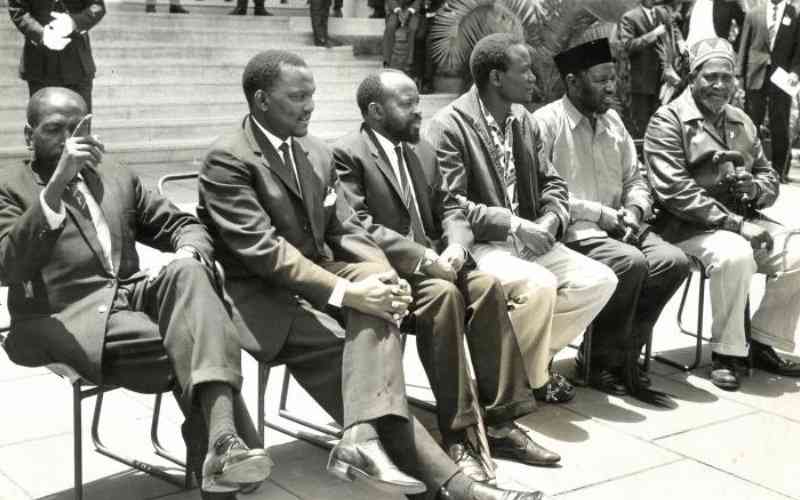
Kapenguria six former prisoners (from left to right) Kungu Karumba, Paul Ngei, Bildad Kaggia, Achieng Oneko, Fred Kubai and Jomo Kenyatta. [File, Standard]
A trip to West Pokot County came along with the opportunity of finally bringing my history classes and lessons to life. In particular, a visit to the Kapenguria Museum to learn about the beginnings of modern Kenya.
The flight to Eldoret from Nairobi is short (45 minutes) and smooth. An hour later, we are driving along the Eldoret-Kitale highway on my way to my five-day visit to West Pokot.
Two hours later, we are in Kapenguria. The town is an attraction for its rich history, part of which is it is home to the Kapenguria Museum, a must-visit, especially if one is keen to learn about the famous six and the colonial history in Kenya.
The town is a cosmopolitan one, mostly thanks to the many NGOs here. The town, once sparsely populated is now well-planned and quite busy.
At the museum, I meet the curator.
The museum is located inside the prison where prominent leaders of the Kenyan independence movement - commonly referred to as the Kapenguria Six were detained.
The museum features galleries in the former cells of the prison, including displays on these leaders and the struggle against colonialism, and houses a memorial library in their honour.
Like is the practice since the establishment of the earliest known museum, museums have been associated with academia and the preservation of rare items. Kapenguria Museum as I find out, is no exception. Here, you will find collections of interesting items, alongside educational sessions.
The cell rooms for the Kapenguria Six, I notice, have undergone only minimal refurbishment, mostly with preservation in mind.
The six famous Kenyans were Bildad Kaggia, Kung'u Karumba, Jomo Kenyatta, Fred Kubai, Paul Ngei and Achieng' Oneko. They were arrested in 1952, tried in Kapenguria in 1952-53, and imprisoned there.
Each numbered cell room is complete with pictures, preserved personal items and well-curated narratives. This helps a visitor take an unguided tour in case they would rather have a personal leisure tour.
At the Museum I also get to 'connect' with other history-making personalities such as Tegla Chepkite Loroupe. The curator narrates how the 1979-born long-distance runner put Kenya on the global map by winning the 25 and 30 kilometres and world marathon records.
She is also a three-time World Record half-marathon champion. Loroupe is also the first woman from Africa to win the New York City Marathon, which she won twice. She has won other marathons in other global cities.
She is also a global spokeswoman for peace, women's rights and education.
Re-living the lives of the Kapenguria Six
The most famous of the six was Jomo Kenyatta. In 1947, he was elected President of KAU, through which he lobbied for independence from British colonial rule, attracting widespread indigenous support, but animosity from white settlers.
In 1952, he was arrested and charged alongside five others with masterminding the anti-colonial Mau Mau Uprising.
Although protesting his innocence - a view shared by later historians - he was convicted and remained imprisoned at Lokitaung until 1959 and was then exiled to Lodwar until 1961 when he was released.
Then there was Fred Kubai (1917-1996).
He attended Buxton High School in Mombasa, graduating in 1931. He then worked for the East African Post and Telecommunications as a telegraphist from 1931 to 1946. During World War II, he also served as part of the telegraph battalion in the British Army in Lodwar.
Ramogi Achieng Oneko (1920-2007) was charged as "Accused No.3." After they were convicted, all six appealed the conviction. However, the appeal judges found that Oneko had largely been convicted on the weight of a Kenya African Union meeting that he had attended.
The statements at the meeting were mostly in Kikuyu, which he did not understand. Although the judges acquitted him of the charges on January 15, 1954, he was still held in detention with the other five.
The fourth member, Paul Joseph Ngei (1923-2004), was born at Kiima Kimwe near Machakos township, Kenya. He was the grandson of paramount chief Masaku after whom the town and the district were named.
Ngei went on to hold several government ministerial positions after Kenya became independent.
Bildad Mwaganu Kaggia (1921-2005) was a member of the Mau Mau Central Committee and had a passion for serving the poor.
After independence, he became a Member of Parliament. He became a militant, fiery nationalist who wanted to serve the poor and landless people. Because of this, he fell out irreconcilably with Jomo Kenyatta.
The last is Kung'u Karumba. Following Kenya's independence, he remained a close friend and influential advisor to Kenyatta.
 The Standard Group Plc is a multi-media organization with investments in media
platforms spanning newspaper print
operations, television, radio broadcasting, digital and online services. The
Standard Group is recognized as a
leading multi-media house in Kenya with a key influence in matters of national and
international interest.
The Standard Group Plc is a multi-media organization with investments in media
platforms spanning newspaper print
operations, television, radio broadcasting, digital and online services. The
Standard Group is recognized as a
leading multi-media house in Kenya with a key influence in matters of national and
international interest.
